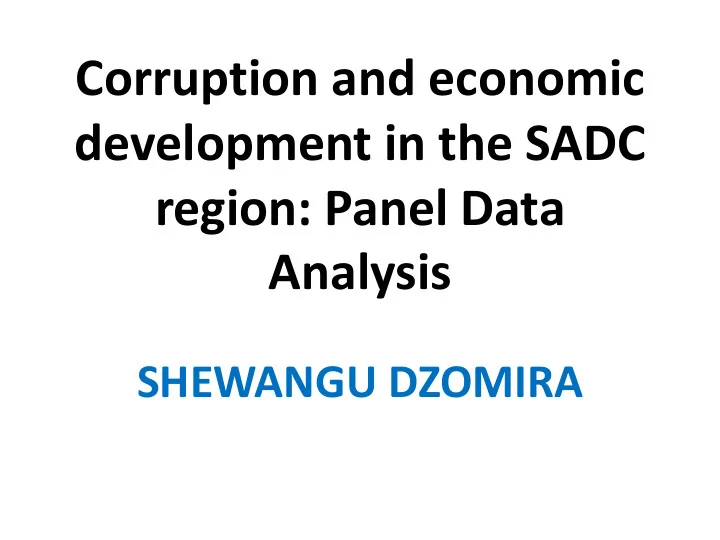

Corruption and economic development in the SADC region: Panel Data Analysis SHEWANGU DZOMIRA
INTRODUCTION • Jain (2001) identifies three kinds of corruption: grand corruption, bureaucratic corruption, and legislative corruption . • Corruption is a self-motivated chapter which has enormously affected economic development and has been at hand since ages. • It is widespread predicament that has demonstrated to be more injurious in the SADC region.
LITERATURE REVIEW • Corruption hampers economic development (Dissou & Yakautsava, 2012; Ajie & Wokekoro, 2012; Adenike, 2013; Matthew and Idowu, 2013; Saha and Gounder, 2013; Dhull, 2014) etc
Country 2017 2016 2015 2014 2013 2012 Bots 61 60 63 63 64 65 Namibia 51 52 53 49 48 48 Mauritius 50 54 53 54 52 57 SA 43 45 44 44 42 43 Lesotho 42 39 44 49 49 45 Zambia 37 38 38 38 38 37 Tanzania 36 32 30 31 33 35 Malawi 31 31 31 33 37 37 Moza 25 27 31 31 30 31 Madgscr 24 26 28 28 28 32 Zim 22 22 21 21 21 20 DRC 21 21 22 22 22 21 Angola 19 18 15 19 23 22
70 Bots 60 Namibi a 50 Mauriti us 40 SA 30 Lesoth o 20 Zambia Tanzan 10 ia Malawi 0 2010 2012 2014 2016 2018
Methodology • 13 countries out of 15 SADC states were considered. The excluded 2 countries were Swaziland and Seychelles. • The data was drawn from The World Bank (World Development Indicators), United Nations Development Programme (Human Development Index) and Transparent International (Corruption Perceptions Index).
• The paper adopted the bounded rational corruption model of Suriya and Pruekruedee (2014) which was put into empirical studies by the suggestion of an econometric model and some possible estimation methods. • It constructs the econometric model including Corruption Perceptions Index as part of the variables (Volrasarn and Harnpornchai, 2014). • Stata was used to analyse the panel data using random-effects GLS regression.
• Reviewing the recent literature regarding the relationship between corruption and economic growth, corruption appears that it influences economic growth through several channels. • Many models have been applied to measure this relationship and the most popular method is a regression model.
Discussion of findings GDPpercapta = - 4198.02+5.628915*CPIscore+2.02 8195*FDI+-897.72*6POPGRWTH+- 2.00314*CPIindex+16998.37*HDI
Random-effects GLS regression R-sq: within = 0.1733 between = 0.8426 overall = 0.8411 Wald chi2(5) = 55.99 Prob > chi2 = 0.0000
GDPperca Std. [95% Interva pta Coef. Err. z P>|z| Conf. l] CPIscore 5.62892 14.5853 0.39 0.700 -22.958 34.2155 FDI 2.0282 7.85352 0.26 0.796 -13.364 17.4208 POPGRW TH -897.73 396.928 -2.26 0.024 -1675.7 -119.76 CPIndex -2.0031 2.10993 -0.95 0.342 -6.1385 2.13224 HDI 16998.4 3410.67 4.98 0.000 10313.623683.2 cons -4198 2296.87 -1.83 0.068 -8699.8 303.757
• The parameter estimate for the variable CPIscore is 5.628915, nevertheless, the increase is not statistically significant as evidenced by the P-value (0.7). The study’s results concur with other empirical literature which confirms the significant negative impact of corruption on economic growth (Mauro, 1997; Stapenhurst etal, 2014; Ugur & Dasgupta, 2011; Ajie and Wokekoro, 2012; Matthew and Idowu, 2013; Dissou & Yakautsava, 2012; Saha & Gounder, 2013)
• The coefficient for the variable FDI is 2.028195; even though the increase is not statistically significant as reflected by (0.796) P-value There is a consensus in the literature that corruption is harmful for a society as it deters FDI which has got a huge impact on economic development (Stapenhurst etal, 2014; Ugur & Dasgupta, 2011; Ajie and Wokekoro, 2012; Matthew and Idowu, 2013; Ertimi & Saeh, 2013).
• The coefficient for the variable POPGRWTH is -897.726 meaning that increase of one-unit in POPGRWTH leads to a decrease in GDPpercapta by - 897.726. The effect is relatively statistically significant as is shown by (0.024) P-value. • Parameter estimate for the variable HDI is 16998.37. The effect is statistically significant as evidenced by (0.000) P- value.
Conclusions & Implications • The study concludes that economic development as measured by GDP per capita increases as the countries’ CPI score improves. • SADC countries need increase oversight potential, such that it becomes easier to scrutinize and control the government and its activities, and, since controlling the government is a key component of all anticorruption strategies, the more a government is subject to control, the more likely it is that corruption will be reduced.
• Reduction in corruption increases FDI that subsequently increases economic development. • The study also concludes that improvement in Human capital development increases economic development in the SADC region as it reduces corruption. • However, an increase in population growth decreases economic growth as measured by GDP per capita.
Thank you Contributions Only
Recommend
More recommend